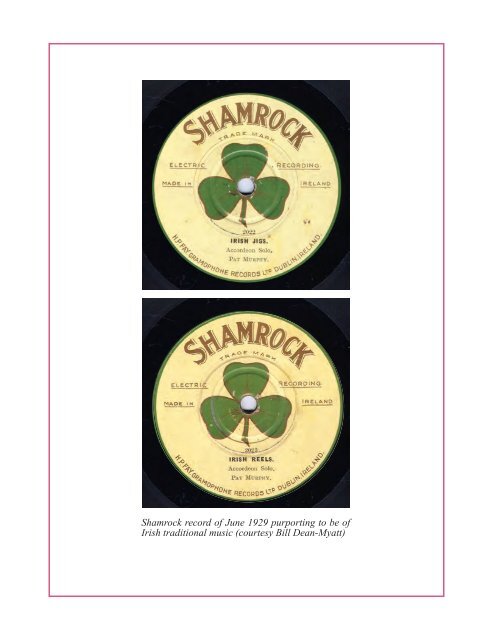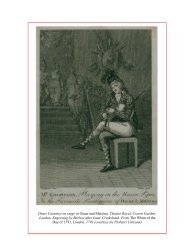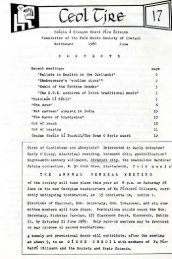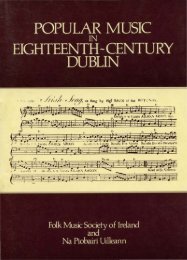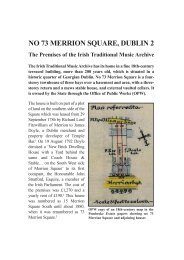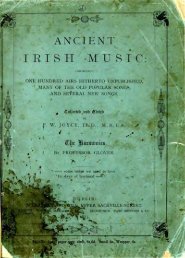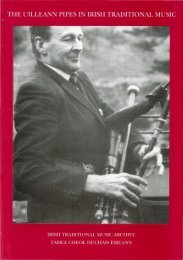Union Pipes - Irish Traditional Music Archive
Union Pipes - Irish Traditional Music Archive
Union Pipes - Irish Traditional Music Archive
You also want an ePaper? Increase the reach of your titles
YUMPU automatically turns print PDFs into web optimized ePapers that Google loves.
Shamrock record of June 1929 purporting to be of<br />
<strong>Irish</strong> traditional music (courtesy Bill Dean-Myatt)
SHAMROCK RECORDS: THE FIRST IRISH-MADE<br />
COMMERCIAL DISCS 1928–1930<br />
Nicholas Carolan, <strong>Irish</strong> <strong>Traditional</strong> <strong>Music</strong> <strong>Archive</strong>, Dublin<br />
Version 1.0 as at 14 November 2012 1<br />
While sound recording has been carried out in Ireland since 1878,<br />
when the first tinfoil-cylinder machines were introduced, 2 no<br />
commercial recordings were manufactured in the country for the first<br />
fifty years of the medium’s existence. <strong>Irish</strong> performers went to Britain<br />
to be recorded, or British companies came to Ireland on brief recording<br />
excursions, but the resulting cylinders and discs were made in<br />
Britain. It was as late as 1928 before an attempt was made to set up<br />
an <strong>Irish</strong> manufacturing company. This attempt, like many another in<br />
the still young industry, was accompanied by a measure of sharp<br />
practice. In time it was to be revealed as an episode in the chequered<br />
business and criminal career of one of its principals.<br />
H.P. Fay Gramophone Records Ltd was registered as a new private<br />
company in the <strong>Irish</strong> Free State on 11 December 1928 with nominal<br />
capital of £1,000 in shares of £1. The first directors were two subscribers<br />
of 500 shares each: Arthur William Greenhill, Pontifex House,<br />
Shoe Lane, London, director of Greenhill & Sons Ltd, London; and<br />
Hugh Patrick Fay of the same address, engineer. Greenhill was British,<br />
Fay <strong>Irish</strong>. The registered office was at 28A Arran Quay, Dublin. 3<br />
1<br />
More relevant information on Shamrock Records will emerge in the future, and<br />
the article will be updated here to include such information as it is found. The<br />
essay should be cited by author, title, version and date on www.itma.ie as above.<br />
Additions can be sent to shamrock.records@itma.ie.<br />
2<br />
Nicholas Carolan, ‘The Talking Machine Comes to Ireland’, in Dear Far-Voiced<br />
Veteran: Essays in Honour of Tom Munnelly, ed. Anne Clune, Old Kilfarboy<br />
Society, Co Clare, 2007: 73–83.<br />
3<br />
Public Record Office – now National <strong>Archive</strong>s of Ireland – file 7812 D; The <strong>Irish</strong><br />
Times, Dublin, 21 Dec. 1928: 11.
SHAMROCK ReCORDS: THe FIRST IRISH-MADe COMMeRCIAL DISCS 1928–1930 2<br />
The main business of Greenhill & Sons was the manufacture of<br />
accessories for the motor and cycle trade, 4 but Arthur William<br />
Greenhill had a personal interest in sound recording and in May 1928<br />
had applied for a patent for ‘improvements in or relating to talkingmachine<br />
sound-record members, such as disks, and methods of<br />
making the same’. 5 He was doubtless a son of the J.e. Greenhill who<br />
in 1891 patented the ‘Greenhill Mechanical Phonograph Motor’,<br />
which was manufactured in London. 6<br />
Hugh Patrick Fay was an ‘American engineer and businessman’ who<br />
had been ‘born and reared in Donabate’, Co Dublin. 7 <strong>Irish</strong> census<br />
records for 1901 and other sources show that he was born in 1889.<br />
He was, in the census year, still at school and living in Ballalease<br />
West, Donabate, Co Dublin, the only son and middle child of three<br />
children born to Mathew Fay, a seemingly prosperous farmer originally<br />
from Co Cavan, and his wife Margaret. 8 In 1904, at the age of<br />
15, Fay emigrated to New York. 9 As the <strong>Irish</strong> partner of the new company,<br />
he would go on to handle publicity in Dublin and be its public<br />
face. He told newspaper reporters that he had been ‘associated for<br />
4<br />
The British Motor & Cycle Standard Catalogue, The Standard Catalogue Co Ltd,<br />
London, [1923–5]: 5, 22. Celluloid was the main component of the company’s<br />
products.<br />
5<br />
espacenet patent search at http://worldwide.espacenet.com, accessed 8 Aug. 2012.<br />
6<br />
George Frow, ‘Prime Mover’, Hillandale News, London, no 72, Apr. 1973:<br />
38–41; ‘The December 2000 and April 2001 Sales, Revisited’, Hillandale News,<br />
no 236, Winter 2001–2002: 432.<br />
7<br />
<strong>Irish</strong> Independent, Dublin, 9 Jan. 1929: 9.<br />
8<br />
www.census.nationalarchives.ie, accessed 4 Aug. 2012. From the census records<br />
alone he could also have been born in 1890, but a variety of other sources quoted<br />
below confirm the date of 1889. The 1911 census records show only the parents<br />
living on the family farm.<br />
9<br />
‘Passenger Lists leaving UK 1890–1960’, accessed via www.findmypast.ie, 31 Oct.<br />
2012. This source confirms his date of birth as 1889 and classifies him as a labourer.
3<br />
SHAMROCK ReCORDS: THe FIRST IRISH-MADe COMMeRCIAL DISCS 1928–1930<br />
years with the gramophone trade and [had] travelled extensively in<br />
Germany, America, and Japan’. 10<br />
Hugh Patrick Fay had indeed been associated for some years with<br />
the gramophone trade. In New York in 1921, when he was in his early<br />
thirties and head of sales and distribution for the<br />
Siemon Hard Rubber Company, 11 he<br />
had also become ‘President and<br />
Managing Director’ of the shortlived<br />
Gaelic Phonograph Record<br />
Co. This had its offices first at<br />
637 Madison Avenue, a<br />
prestigious-sounding address, 12<br />
and it advertised 31 doublesided<br />
discs for sale in the November<br />
of that year, including<br />
recordings of songs in the <strong>Irish</strong><br />
language. 13 The artists were mostly <strong>Irish</strong>born:<br />
popular and semi-classical singers, ‘<strong>Irish</strong> tenors’ among them;<br />
and traditional instrumentalists whose recordings are still sought<br />
after, such as the piccolo player P.J. McNamara of Limerick city, the<br />
accordion player Patrick J. Conlon of Co Galway, and the<br />
10<br />
Evening Herald, Dublin, 17 July 1929: 1.<br />
11<br />
Allan Sutton & Kurt Nauck, American Record Labels and Companies: An<br />
Encyclopedia (1891–1943), Mainspring Press, Denver, Colorado, 2000: 283.<br />
12<br />
Google tells us that the School of American Ballet was founded by George<br />
Balanchine at that address in the 1930s.<br />
13<br />
The Gaelic American, New York, 5 Nov. 1921: 2; 12 Nov. 1921: 2; 19 Nov. 1921:<br />
2. I am obliged to my colleague Harry Bradshaw for these leads to Hugh Patrick<br />
Fay’s earlier adventures in the record trade. My recounting of the Smithfield-<br />
Shamrock story to him triggered his memory of Fay’s involvement in <strong>Irish</strong>-<br />
American sound recording in New York and a donation of the appropriate<br />
references.
SHAMROCK ReCORDS: THe FIRST IRISH-MADe COMMeRCIAL DISCS 1928–1930 4<br />
Chicago-born uilleann piper Tom ennis. In spite of such a fullblooded<br />
start, and at least three more issues, 14 the company quickly<br />
ran into difficulties. It moved to 40 West 57th Street in February<br />
1922, and Fay was replaced as managing director in the following<br />
month. 15 In March 1923 Gaelic filed for bankruptcy. 16<br />
Six years later, in Dublin, the new Fay Gramophone registration was<br />
quickly followed up in early 1929 with the exciting news that the<br />
company had acquired premises in Smithfield, in north central<br />
Dublin, and that plant had been installed for the manufacture of<br />
gramophone records. The making of celluloid fancy goods and toys,<br />
and gramophones and radios, was also envisaged. Operations were<br />
to start on 1 February, and it was hoped that some 250 people would<br />
eventually be employed. It was proposed to produce 8-inch records<br />
for sale at 1/3 each and 10-inch records for 2/6. According to Fay,<br />
the project would involve an outlay of £20,000, and it was intended<br />
that the factory would eventually produce 6,000 records a day. 17 A<br />
company premises seems also to have been opened at no 36 Pearse<br />
St in south central Dublin, a shopfront premises which was called<br />
‘Shamrock Gramophone House’ from 1928. 18<br />
The Fay company advertised for a sales manager in April 1929, 19 and<br />
by June it was reported that 1,000 copies of each of fifteen records<br />
14<br />
Talking Machine World, New York, Mar. 1922: 159.<br />
15<br />
Talking Machine World, Mar. 1922: 155.<br />
16<br />
Sutton & Nauck: 85, 283.<br />
17<br />
<strong>Irish</strong> Independent, 9 Jan. 1929: 9. The premises was a ‘former skin and hide store’.<br />
There were several such on Smithfield and it has not been possible to identify the<br />
Shamrock premises.<br />
18<br />
Thom’s Official Directory of Ireland for the Year 1928, Alex. Thom & Co., Dublin,<br />
1928: 2062. The entry also appears in the issues for 1929, 1930 and 1931, but not<br />
subsequently. Strangely, none of the issues gives an address for H.P. Fay Ltd or<br />
Shamrock Records in Smithfield.<br />
19<br />
The <strong>Irish</strong> Times, 25 Apr. 1929: 1.
5<br />
SHAMROCK ReCORDS: THe FIRST IRISH-MADe COMMeRCIAL DISCS 1928–1930<br />
From Ireland’s Own, Wexford, 20 July 1929
SHAMROCK ReCORDS: THe FIRST IRISH-MADe COMMeRCIAL DISCS 1928–1930 6<br />
had been distributed. 20 They were produced on a ‘Shamrock’ label, 21<br />
and they had been pressed, it was said, from ‘mother’ records made<br />
in America. Negotiations were in progress for the building of a studio<br />
in Findlater House at 50 O’Connell Street, Dublin, for the purpose of<br />
recording local artists. A ready demand was expected for these records<br />
in Ireland and in America with its 30,000,000 <strong>Irish</strong> ‘kith and kin’. 22<br />
The new company was evidently aware of the strong contemporary<br />
interest in <strong>Irish</strong> traditional culture and its collection, an interest that<br />
had led to the formation of the Folklore of Ireland Society in 1927<br />
and would lead to the <strong>Irish</strong> State’s creation of the <strong>Irish</strong> Folklore<br />
Commission in 1935. Over the next few months <strong>Irish</strong> folklore and<br />
music, and songs, jigs, reels and marches were to be put on records<br />
in Dublin and disseminated around the world, according to Fay, and<br />
a select party was to explore the remotest parts of Ireland in search<br />
of the ‘true Gaelic culture’. 23 By July 1929 he was claiming that he<br />
was about to begin ‘an extensive Tour of Ireland with our Recording<br />
Van, making tests of <strong>Traditional</strong> <strong>Irish</strong> <strong>Music</strong> to be submitted to our<br />
<strong>Music</strong>al Director, and our Permanent Recording Studios and Band<br />
Rooms will Open at 28 Upper O’Connell St. in a fortnight’s time’.<br />
He also issued a warning about a non-<strong>Irish</strong> ‘recording apparatus’ that<br />
had been touring the country in search of <strong>Irish</strong> talent. 24<br />
20<br />
<strong>Irish</strong> Independent, 15 June 1929: 6.<br />
21<br />
As might be expected, there have been several other Shamrock labels in existence<br />
over the decades, some of them 78 labels of the name published in <strong>Irish</strong> America<br />
in the 1920s and 1950s, and at least one a microgroove label published in Ireland<br />
in the 1960s and 1970s.<br />
22<br />
Evening Herald, 17 July 1929: 1. No mention of Shamrock Records has been<br />
found in the contemporary <strong>Irish</strong>-American press.<br />
23<br />
Evening Herald, 17 July 1929: 1.<br />
24<br />
<strong>Irish</strong> Independent, 3 July 1929: 5. This rival operation was doubtless that of the<br />
Parlophone Company of London which had come on the first of two productive<br />
recording trips to Ireland in mid-1929 (see www.itma.ie/digitallibrary). The<br />
resulting records were manufactured in Britain.
7<br />
SHAMROCK ReCORDS: THe FIRST IRISH-MADe COMMeRCIAL DISCS 1928–1930<br />
From <strong>Irish</strong> Independent,<br />
Dublin, 3 July 1929
SHAMROCK ReCORDS: THe FIRST IRISH-MADe COMMeRCIAL DISCS 1928–1930 8<br />
An option had been taken by Fay on a factory in Rathmines, it was<br />
reported, for the future manufacture of gramophones and radios. 25<br />
Young employees, including a ‘dozen pretty girls’, had been trained<br />
by experts from england. Twenty-five thousand discs of the June<br />
1929 issue had been made on the company’s eight pressing<br />
machines. 26<br />
Surviving copies show that Shamrock records were 10" double-sided<br />
discs. A large green gold-edged shamrock featured as a central logo,<br />
and lettering was in gold and black on a cream background, all<br />
suggestive of the <strong>Irish</strong> national flag. They were issued by ‘H.P. Fay<br />
Gramophone Records Ltd., Dublin, Ireland’, and were, the labels proclaimed,<br />
the product of ‘electric recording’ and ‘made in Ireland’.<br />
Local dealers began to advertise the new records: ‘McHugh’s have<br />
the new Dublin-made “Shamrock Records”. Come and hear the first<br />
<strong>Irish</strong>-made records at 59 Talbot St. (at the Bridge) [Dublin]’. 27<br />
Provincial agents were appointed: ‘Sheridan’s Gramophone Stores,<br />
Ceannanus Mór [Kells, Co Meath]... We are also Agents for the New<br />
<strong>Irish</strong>-made “SHAMROCK” Records’. 28 Three hundred dealers<br />
throughout Ireland were said to be carrying the records. 29<br />
25<br />
Another company – ‘Orchestraphone Company Ltd’ – was registered by Fay and<br />
Greenhill for the making of gramophone records and gramophones on 25 Mar.<br />
1929 with nominal capital of 100 £1 shares. Both gave their address as the<br />
Gresham Hotel, one of Dublin’s leading hotels. This company was also involved<br />
in experimentation with sound for film, and gave a ‘synchronised sound films’<br />
trade-show demonstration in the Stella Cinema, Rathmines, Dublin, in Apr. 1929.<br />
The demonstration was only partially successful, perhaps because of the physical<br />
limitations of the cinema (<strong>Irish</strong> Independent, 9 Apr. 1929: 10). This company<br />
was dissolved by the Registrar of Joint Stock Companies on 28 Aug. 1931<br />
(Public Record Office – now National <strong>Archive</strong>s of Ireland – file 7850 D).<br />
26<br />
Evening Herald, 17 July 1929: 1; Ireland’s Own, Wexford, 20 July 1929: 62.<br />
27<br />
<strong>Irish</strong> Independent, 25 June 1929: 14.<br />
28<br />
The Meath Chronicle, Navan, 10 Aug. 1929: 3.<br />
29<br />
Evening Herald, 17 July 1929: 1.
9<br />
SHAMROCK ReCORDS: THe FIRST IRISH-MADe COMMeRCIAL DISCS 1928–1930<br />
From <strong>Irish</strong> Independent, Dublin, 1 July 1929<br />
Newspapers greeted the discs uncritically: they were ‘superb<br />
records’, a ‘triumph of skill in <strong>Irish</strong> manufacture’, and ‘everything<br />
in connection with the records is <strong>Irish</strong>, including the wrappers and<br />
printing’, according to the Evening Herald of Dublin. 30<br />
It is not known for certain what records were available by June 1929,<br />
but they included the discs<br />
S2004 &<br />
S2005<br />
S2014 &<br />
S2015<br />
S2018 &<br />
S2019<br />
Doreen McCoy: Where Have You Been All My Life? Foxtrot<br />
Song (“Lucky Girl”). (Robin, Furber, Charig); Is There<br />
Anything Wrong with That? (H. Magidson, M.H. Cleary)<br />
Seamus O’Brien, vocal: The Soldier’s Song; My Dark<br />
Rosaleen<br />
<strong>Irish</strong> Soldiers’ Band: Moore’s Melodies Selection;<br />
Dear Little Shamrock Selection<br />
30<br />
Issue of 5 July 1929: 5.
SHAMROCK ReCORDS: THe FIRST IRISH-MADe COMMeRCIAL DISCS 1928–1930 10<br />
S2022 &<br />
S2023<br />
S2029<br />
Pat Murphy, accordion, with piano: <strong>Irish</strong> Jigs; <strong>Irish</strong><br />
Reels<br />
Michael O’Connell, with piano accompaniment: The<br />
Hills of Donegal. <strong>Irish</strong> song. (P.J. O’Reilly, W.<br />
Sanderson); Jere Conway: Danny Boy 31<br />
The Shamrock July 1929 list, according to a newspaper<br />
advertisement from the company, consisted of twelve issues in an S<br />
series which was now using a single catalogue number for each disc,<br />
and included discs that did not purport to be <strong>Irish</strong> but were of what<br />
would have then been called ‘jazz music’:<br />
S2030<br />
S2031<br />
S2032<br />
S2033<br />
S2034<br />
Shamrock Concert Orchestra: Bohemian Girl (overture;<br />
Balfe); Wine, Women and Song (waltz; Strauss)<br />
Shamrock Concert Orchestra: Blue Danube (waltz;<br />
Strauss); Light Cavalry (overture; Suppé)<br />
Seamus O’Leary, tenor: Yes! Let Me like a Soldier Fall<br />
(‘Maritana’; Wallace), matrix 132A; Andy Doyle,<br />
baritone: The Floral Dance (K. Moss), matrix 133A<br />
Seamus O’Leary, tenor, with orchestra: There is a<br />
Flower that Bloometh (‘Maritana’; Wallace); Andy Doyle,<br />
baritone, with orchestra: The Bandolero (Leslie Stuart)<br />
James McDonnell, tenor, & male chorus: Take a Pair<br />
of Sparkling eyes (‘The Gondoliers’; Sullivan); Tony<br />
O’Moore, tenor: The Old Rustic Bridge by the Mill<br />
31<br />
Listed for sale on www.offtherecord.ie, 27 Sept. 2012.
11<br />
SHAMROCK ReCORDS: THe FIRST IRISH-MADe COMMeRCIAL DISCS 1928–1930<br />
S2035<br />
S2036<br />
S2037<br />
S2038<br />
S2039<br />
S2040<br />
S2041<br />
Seamus O’Reilly, tenor: eily Mavourneen (‘Lily of<br />
Killarney’; Benedict), matrix 135A; Denis Forde,<br />
tenor: Molly Bawn (Lover), matrix 135B<br />
Dan Hynes, Ireland’s premier xylophone player: My<br />
<strong>Irish</strong> Lass (jig; W. Whitlock); Mac’s Birthday (jig; W.<br />
Whitlock)<br />
<strong>Irish</strong> Soldiers’ Band: Colonel Bogey (march; Alford);<br />
O’Flanagan Brothers, accordion duet: La Paloma<br />
(Tradier)<br />
<strong>Irish</strong> Soldiers’ Band: el Capitan (march; Sousa);<br />
O’Flanagan Brothers, accordion duet: Blaze Away<br />
(march; Holzmann)<br />
Bill Johnstone, Chicago’s Black-Faced Star: There’s<br />
a Rainbow round My Shoulder (Jolson, Rose, Dryer);<br />
Old Man Sunshine (Dixon & Warren)<br />
Plaza Dance Band: Glad Rag Doll (foxtrot; Yeller,<br />
Ager, Dougherty); The Novelty Dance Orchestra:<br />
Beloved (waltz; Kahn & Sanders)<br />
Plaza Dance Band: Just a Night for Meditation (foxtrot;<br />
Lewis, Young & Pollack); The Novelty Dance<br />
Orchestra: King for a Day (waltz; Lewis, Young &<br />
Fiorito) 32<br />
32<br />
<strong>Irish</strong> Independent, Dublin, 1 July 1929: 10, and from discs in the collection of the<br />
<strong>Irish</strong> <strong>Traditional</strong> <strong>Music</strong> <strong>Archive</strong>. Additional composer etc. information has been<br />
supplied from Karlo Adrian & Arthur Badrock eds, Edison Bell Winner Records<br />
(second, revised edition; with history of Winner by Frank Andrews), e. Bayly,<br />
Bournemouth, 1989: passim; and from Bill Dean-Myatt, pers. comm., Aug. 2012.
SHAMROCK ReCORDS: THe FIRST IRISH-MADe COMMeRCIAL DISCS 1928–1930 12<br />
All the ‘<strong>Irish</strong>’ artists are otherwise unknown by name, and it is certain<br />
that the original recording artists (who were not <strong>Irish</strong>) were all given<br />
hibernian pseudonyms by the company to make them more attractive<br />
to its target audience. Since the original recordings were said to have<br />
been made in America, it could be believed that they were recorded<br />
by <strong>Irish</strong>-American performers who were unknown in the homeland.<br />
The ‘O’Flanagan Brothers’ were doubtless meant to give the<br />
impression of being the Flanagan Brothers, a genuine and successful<br />
Waterford family group of recording artists in 1920s <strong>Irish</strong> America,<br />
one that may have recorded earlier for Fay’s Gaelic Phonograph<br />
Company in New York. 33<br />
The chicanery did not end there. Most of the masters were recorded<br />
not in America, as stated, but in england by the edison Bell Company<br />
of London, and it is certain that not all of them were electrically<br />
recorded. 34 On the evidence of identity of repertory, and similarity of<br />
instrumentation, vocal category, disc pairings, issue dates, etc., many<br />
of the Shamrock artists are to be found on the Winner label of edison<br />
Bell, and some on its Velvet Face label. The ‘O’Flanagan Brothers’<br />
are revealed to be the Macari Brothers, a London piano-accordion<br />
duet whose recordings of ‘La Paloma’ and ‘Blaze Away’ were released<br />
on Winner disc 4790 in March 1928. ‘Doreen McCoy’ must be the<br />
American comedienne Beth Challis on Winner 4872 and Winner<br />
33<br />
For the Flanagans, see the Viva Voce CD Tunes We Like to Play on Paddy’s Day<br />
(VIVAVOCe007, Dublin, 1996).<br />
34<br />
The following analysis is based on Adrian & Badrock 1989. edison Bell did reissue<br />
some discs from such American labels as Paramount, Gennett and Domino, and it<br />
is just possible that some of these appeared on Shamrock. I am grateful to Bill<br />
Dean-Myatt for suggesting possible Winner sources for Shamrock Records and<br />
supplying me with his research notes. electrical recording was first introduced by<br />
the record industry in America in 1924–25; and the first electrical Winner recording<br />
was issued in Apr. 1926 (Adrian & Badrock 1989: [4]).
13<br />
SHAMROCK ReCORDS: THe FIRST IRISH-MADe COMMeRCIAL DISCS 1928–1930<br />
Shamrock 2022 and its acoustic original of 1914:<br />
Edison Bell Winner 2582 (courtesy Bill Dean-Myatt)
SHAMROCK ReCORDS: THe FIRST IRISH-MADe COMMeRCIAL DISCS 1928–1930 14<br />
4879, both issued in February 1929. ‘Seamus O’Brien’ may be a<br />
composite of baritone Seamus McCarthy (Winner 3612, February<br />
1922) and baritone Jerome Murphy (Winner 3627, also February<br />
1922). The ‘<strong>Irish</strong> Soldiers’ Band’ is the Band of H.M. <strong>Irish</strong> Guards<br />
(Winner 2683, September 1914, and Winner 4636, August 1914). ‘Pat<br />
Murphy’ is, on at least one track, the North of england accordion<br />
player Jack Williams who recorded ‘<strong>Irish</strong> Jigs’ (Winner 2582, April<br />
1914). 35 The ‘Shamrock Concert Orchestra’, oddest of all, is actually<br />
the Margate Municipal Orchestra conducted by Bainbridge Robinson<br />
(Winner 4396, May 1926). Tenor ‘Seamus O’Leary’ is likely John<br />
Perry (Velvet Face 1132, July 1925), while baritone ‘Andy Doyle’ is<br />
Robert Carr (Winner 3939, February 1924). ‘James McDonnell’ is<br />
possibly the tenor Wilson Pembroke (Winner 2016, February 1912),<br />
‘Tony O’Moore’ John Lovering and chorus (Winner 2515, post<br />
December 1913), and ‘Denis Forde’ edward Wilson (Winner 4350,<br />
March 1926). ‘Ireland’s premier xylophone player Dan Hynes’ is the<br />
englishman Billy Whitlock, composer of the pieces ‘Mac’s Birthday’<br />
(Winner 5342) and ‘My <strong>Irish</strong> Lass’ (Winner 5355), both released September<br />
1917. Older items from the Winner back-catalogue that could<br />
be passed off as <strong>Irish</strong>-American were obviously being cherry-picked,<br />
as were recent recordings that would appeal to more modern tastes.<br />
On the other hand, genuine and recent <strong>Irish</strong> Winner artists, of whom<br />
there were several, could not be released on Shamrock as their records<br />
would already have been well known in Ireland.<br />
By late August 1929 an obscure legal dispute had arisen between the<br />
founding shareholders Greenhill as plaintiff and Fay as defendant. It<br />
seems that Greenhill as Chairman had appointed extra directors, Doris<br />
Peggy Greenhill and Mrs T.A. O’Reilly, and that Fay had interfered<br />
35<br />
Identification of Williams by Bill Dean-Myatt from a Winner disc in his<br />
possession (pers. comm. Aug. 2012). He thinks that the Murphy ‘<strong>Irish</strong> Reels’<br />
track may be the track ‘Bits o’ Blarney’ on Williams’ disc Winner 2579.
15<br />
SHAMROCK ReCORDS: THe FIRST IRISH-MADe COMMeRCIAL DISCS 1928–1930<br />
with the running of this new board. An interim injunction was issued<br />
restraining Fay from acting other than as a member of the board. It was<br />
hoped that an amicable solution might be agreed. 36 The name of the<br />
company was changed to ‘Shamrock Gramophone Records Ltd’. 37 In<br />
December 1929 Greenhill was in further business trouble and petitioned<br />
in the High Court in London for the winding up of Greenhill & Sons,<br />
giving his address as 3 Mountjoy Square, Dublin. 38<br />
By February 1930 Shamrock Records itself was in liquidation and<br />
its records, machinery, and office furniture were being sold at<br />
auction. 39 The final winding-up meeting was held on 30 December<br />
1930. 40 Ireland’s first record-manufacturing company had, it seems,<br />
fallen victim to boardroom disagreements and doubtless to the Great<br />
Depression that was universally affecting the record industry. It<br />
would be another six years before disc manufacturing would begin<br />
again in Ireland, when in 1936 the British combines eMI and Decca<br />
would establish a record factory in Waterford to avoid heavy <strong>Irish</strong><br />
import tariffs on foreign-made records.<br />
To this point the Shamrock Records story seems to be a typical story<br />
of a failed business: a reasonable idea brought forward with initial<br />
success but ultimately brought down by external circumstances<br />
beyond its control. Hugh P. Fay quickly bounced back but his illluck<br />
continued. In 1931 he established a new company at 121 Victoria<br />
Street, London: Fay Home Recorders Ltd, renamed the<br />
following year as Fay Radio & Recorders Ltd. This was for a recording<br />
device of his own invention which sat on a standard gramophone<br />
36<br />
<strong>Irish</strong> Independent, 29 Aug. 1929: 4.<br />
37<br />
Public Record Office – now National <strong>Archive</strong>s of Ireland – file 7812 D.<br />
38<br />
The London Gazette, London, 6 Dec. 1929: 7969.<br />
39<br />
The <strong>Irish</strong> Times, 22 Feb. 1930: 16; 26 Feb. 1930: 14.<br />
40<br />
Public Record Office – now National <strong>Archive</strong>s of Ireland – file 7812 D.
SHAMROCK ReCORDS: THe FIRST IRISH-MADe COMMeRCIAL DISCS 1928–1930 16<br />
turntable and recorded onto a ‘Faytone’ aluminium disc. 41 The new<br />
device was introduced in July 1931 to a distinguished gathering<br />
including several MPs in the Park Lane Hotel, and speeches and a<br />
violin solo were recorded and played back to the satisfaction of those<br />
attending. 42 Fay was to be paid £10,000 by the company for his<br />
invention and a salary of £2,000 per annum plus expenses. He later<br />
drew down some £500 in expenses ‘without express authority’. The<br />
firm never traded profitably and it was compulsorily wound up by<br />
court order with debts of some £5,000 in March 1933, Fay and his<br />
wife being among those claiming the assets of the company. 43<br />
Bankruptcy proceedings were taken against him by his creditors,<br />
who were unable to ascertain his address. 44 He had emigrated to<br />
Canada, to Quebec initially. 45<br />
Some ten years later, Hugh Patrick Fay’s appearance in a Dublin<br />
court and his conviction as a fraudster throws a retrospective light<br />
on his attempt to set up an <strong>Irish</strong> record industry.<br />
About 1948 Fay, who had returned to settle in Ireland in 1946, 46<br />
became involved in a business scheme in Dublin which had an<br />
American dimension similar to that claimed for his record project.<br />
He proposed setting up a mineral-water company named Texacola<br />
and canvassed subscriptions for the purpose. Texacola Holdings and<br />
a company called Coco Cola Ltd was registered by him and others,<br />
41<br />
Hillandale News no 77 (Feb.–Apr. 1974): cover, 152.<br />
42<br />
The Gramophone, London (Aug. 1931): 37.<br />
43<br />
Frank Andrews, ‘Guiniphones’, Hillandale News no 80 (Oct. 1974): 233–5.<br />
44<br />
The proceedings were seemingly successful as in 1942 he was applying for discharge<br />
(The London Gazette, 20 June 1933: 4174; 24 Feb. 1942: 945).<br />
45<br />
‘Returns of Passengers Leaving the United Kingdom’, The National <strong>Archive</strong>s,<br />
London, accessed via www.findmypast.ie, 31 Oct. 2012. Again this source<br />
gives his date of birth as 1889. He landed in Canada in April 1933<br />
(www.collectionscanada.gc.ca, accessed 4 Nov. 2012).<br />
46<br />
The <strong>Irish</strong> Times, 22 Mar. 1951: 3.
17<br />
SHAMROCK ReCORDS: THe FIRST IRISH-MADe COMMeRCIAL DISCS 1928–1930<br />
both operating from 1 ely Place Upper. Stating that he had a syrup<br />
to make this unique mineral water and that he had brought over the<br />
secret from America, Fay collected some £3,000 for shares from<br />
various subscribers. 47 The skirting of copyright infringement of the<br />
Coca-Cola company’s famous product was obvious; the American<br />
company successfully took an injunction against the <strong>Irish</strong> one in<br />
March 1951, preventing it from giving the impression that they were<br />
connected. 48 In 1953 Fay was arrested in London and brought to trial<br />
in Dublin for converting the share subscriptions he had received to<br />
his own use. 49 Described as a 65-year-old engineer of no fixed<br />
address, he was unable to get bail and was held in custody. In the<br />
course of the trial, it was revealed that he had gone to the United<br />
States at an early age and had been sentenced in Los Angeles in 1926<br />
to from one to ten years for conspiracy to commit grand larceny. He<br />
had been deported after 18 months, a short time before he began<br />
setting up Shamrock Records in Dublin. Subsequently, in the 1930s,<br />
he had entered Canada illegally, and had been deported from there<br />
in 1937. He conducted his own defense, protesting that his Los<br />
Angeles conviction was for ‘bootlegging – a commercial business’.<br />
In Dublin he was sentenced to four years penal servitude on seven<br />
counts of fraudulent conversion. 50 Hugh Patrick Fay died in<br />
Kensington in London in 1961, aged 72. 51<br />
47<br />
The <strong>Irish</strong> Times, 18 May 1954: 9. The court was told however that the syrup<br />
called Texacola was being sold in Ireland from 1948 by a Texas Guinan who<br />
was employed by an air company at Shannon. Guinan had gone to work in<br />
Saudia Arabia leaving Fay with the formula.<br />
48<br />
The <strong>Irish</strong> Times, 22 Mar. 1951: 3. Fay was represented by the <strong>Irish</strong> Attorney-<br />
General e.C. Micks SC. Costs were given against Fay, but these were not paid<br />
and in Oct. 1952 an order was given for the winding-up of the <strong>Irish</strong> company<br />
(<strong>Irish</strong> Independent, 21 Oct. 1952: 3).<br />
49<br />
<strong>Irish</strong> Independent, 7 May 1954: 5.<br />
50<br />
The <strong>Irish</strong> Times, 11 June 1954: 8; 14 July 1954: 3; 20 July 1954: 7.<br />
51<br />
‘Deaths Registered in October, November and December, 1961’ accessed via<br />
www.findmypast.ie, 31 Oct. 2012. Again this source gives his date of birth as 1889.
SHAMROCK ReCORDS: THe FIRST IRISH-MADe COMMeRCIAL DISCS 1928–1930 18<br />
In the light of his Dublin conviction and his earlier bootlegging<br />
conviction in Los Angeles, the suspicion must now be that Fay’s<br />
dealings in Shamrock Records also were not above board. The<br />
injunction taken against him by Arthur Greenhill and the other<br />
directors indicates that he was acting independently of them in his<br />
running of the company. As the front man on the ground in Dublin<br />
he may have been directing income towards himself, as with<br />
Texacola. The whole elaborate Shamrock project was not set up as<br />
a fraud, but it is likely that Fay was directing the operations to his<br />
own benefit above that of anyone else, especially as his get-rich<br />
scheme began to encounter difficulties. There must also be a<br />
suspicion that the eight pressing machines and other equipment<br />
with which he set up Shamrock manufacturing in Smithfield were<br />
obsolete pieces of equipment belonging to the era of acoustic<br />
recording and acquired cheaply in england as the industry there<br />
retooled for the manufacture of the new electric recordings. And<br />
his 1922 replacement as managing director of the Gaelic<br />
Phonograph Company must also be wondered about.<br />
Given the different forms of deceit involved in the Shamrock<br />
enterprise, it would be reasonable to ask if indeed any of the<br />
label’s discs were ever actually manufactured in Dublin, or if<br />
they had been pressed by edison Bell in London with Shamrock<br />
labels and then exported to Ireland. But the discs were certainly<br />
manufactured in Dublin, as is clear from several pieces of<br />
evidence. Photos showing the manufacturing process, taken in<br />
the Shamrock factory in Smithfield, were published in the<br />
Evening Herald, and its editor himself inspected the premises in<br />
July 1929. 52<br />
52<br />
Evening Herald, 17 July 1929: 1, [10].
19<br />
SHAMROCK ReCORDS: THe FIRST IRISH-MADe COMMeRCIAL DISCS 1928–1930<br />
From evening Herald, Dublin, 17 July 1929. Hugh Patrick Fay is third from<br />
left, holding a record.<br />
The gramophone critic of the magazine Ireland’s Own also visited<br />
the plant in the same month and saw disc manufacturing in<br />
progress. 53 This evidence is confirmed by a detailed advertisement<br />
from Dockrell Ltd, the auctioneers handling the company’s liquidation<br />
sale in February 1930. As well as 10,000 double-sided 10" discs<br />
comprising 23 different records, 24 mother matrices by edison Bell<br />
Ltd, 15 master waxes, and a variety of generators, vats, chemicals,<br />
boxes and crates, the sale included hydraulic presses and pumps,<br />
copper anodes, edging and grinding machines, and a range of<br />
ancillary manufacturing equipment. 54<br />
53<br />
Ireland’s Own, Wexford, 20 July 1929: 62.<br />
54<br />
The <strong>Irish</strong> Times, 22 Feb. 1930: 16.
SHAMROCK ReCORDS: THe FIRST IRISH-MADe COMMeRCIAL DISCS 1928–1930 20<br />
Whatever his faults, the fact remains that Hugh Patrick Fay, along<br />
with Arthur William Greenhill, was the driving force in establishing<br />
the first <strong>Irish</strong> company to manufacture sound recordings, and the<br />
company did press the sound recordings in Dublin. It is hoped that<br />
some twenty-odd different Shamrock recordings survive somewhere<br />
in the world as evidence. The present writer would like to receive<br />
details and copies of them. 55<br />
With thanks to Bill Dean-Myatt (compiler of The Scottish Vernacular<br />
Discography 1888–1960; author of Beltona: A Label Listing and<br />
History, etc.) for his initial query which provoked further research<br />
into Shamrock, and for his contributions to the article as detailed<br />
above; to the staff of the <strong>Irish</strong> <strong>Traditional</strong> <strong>Music</strong> <strong>Archive</strong> and of the<br />
National Library of Ireland; to Harry Bradshaw for leads to H.P.<br />
Fay; to Treasa Harkin for the processing of images; and to Jackie<br />
Small for the preparation of the article for the ITMA website.<br />
<strong>Irish</strong> <strong>Traditional</strong> <strong>Music</strong> <strong>Archive</strong>, www.itma.ie<br />
73 Merrion Square, Dublin 2<br />
tel. +353-1-6619699<br />
55<br />
Information can be emailed to shamrock.records@itma.ie.


